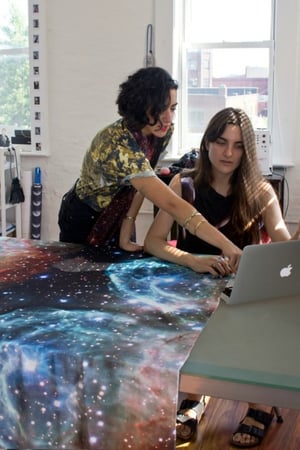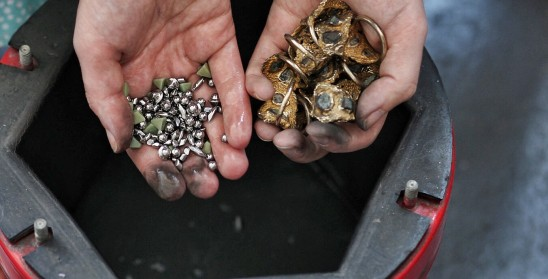Ask an Expert: How to Make Your Product Stand Out
Guest post by Jamie Hoffman, Home Decor and Garden Buyer at UncommonGoods

As a buyer for UncommonGoods, I spend my days scouring craft fairs and trade shows looking for new items to sell in our online shop. I meet a lot of talented artists who’ve worked hard to perfect their products, but who are struggling with how to break into the commercial market.
Sometimes it’s because they haven’t figured out how to scale their production capacity in a way that inspires confidence. Other times it’s because they’re neglecting to frame their work in a way that shows how special it is — be it through photography or written product descriptions. Because of my experience and perspective as a retail buyer, I know that every aspect of developing and showcasing product is an opportunity to share it with the customer.
There are a lot of good products out there. So what makes the great ones rise above the rest? Being able to distinguish your work and your brand from the competition is one of the most powerful things you can do to succeed.
Here is what goes through my mind when I’m considering a new product:
1. Have I Seen This Before?

Show me something I haven’t seen before! I am always on the lookout for new ideas. For example, I am most intrigued by makers who are using materials in unexpected ways. But these days it’s not enough for an item to be simply upcycled or handmade. There needs to be a connection between form and function — what a product does and how it’s been designed — both aesthetically and in terms of how people will interact with your product.
Lately I’ve been impressed by innovations in lighting design — from chandeliers to table lamps and candleholders. I especially love the interactive element of the Mr. Owl Touch Lamp, which I discovered earlier this year at a craft fair in Brooklyn. Immediately, I was drawn in by the lively crowd of people around the booth. Everyone was playing with the lamps, and tapping through the brightness levels. The sheer buzz assured me this product would be a hit.
2. Is It Well-Built / Durable?

When I’m considering a new product, I look at the quality of the materials it’s made from. I ask: is it durable? How long will the product last after people have been using it, cleaning it, dropping it, and interacting with it — even in ways the maker never intended? A product that’s being sold at the retail level needs to be able to handle everyday use and function.
You should always test your materials for performance and durability before showing them to buyers. I might be initially attracted to a product because it is a cute idea, but if the product isn’t well-constructed, I can’t sell it. Professional craftsmanship matters, and it is about so much more than just the creative inspiration behind a finished product. It’s also about the skillfulness and quality of the execution.
3. What Do I Learn from the Packaging and Presentation?
I am always grateful for vendors who go out of their way to make my job easier. That means providing me with everything I need to know about the product up front — in a memorable and engaging way. If you’re submitting your work to me online, high quality photos are a must. I cannot emphasize enough what a difference well-lit, professional images make when I’m considering a new submission.
If you’re exhibiting at a trade show, your booth should make a visual impact that pulls me in from a distance. Attractive, durable, and giftable packaging are also more likely to grab my attention. Once you have my attention, the first thing I look for is a clear and compelling product description. Do you have an elevator pitch? It should fit onto your business card. Customers’ attention spans can be quite short, so you want them to absorb as much of your message as possible in their first few moments with your product. Is it clear how it works and what’s needed for it to function? Make sure instructions are included when necessary.
4. Do I Love the Story?
One of my favorite things about my job is getting to meet all the different kinds of makers and hearing their stories. I’m always interested to learn how an artist first pursued their craft, what obstacles they overcame, and where they got the inspiration for their design. So if there is an exciting story behind your product — you should make a point of getting good at telling it!
One of the most interesting pieces we sell at UncommonGoods is the Do Good Hammock, which is handwoven by the Mlrabi people of northern Thailand. I love this hammock because of the story behind it: the Mlabri people were nearly wiped out a few decades ago when wood harvesters cut down the teak forests they were living in. But traditionally the Mlrabi are incredible weavers, and they’ve been able to turn their artisanal skills into a source of income that’s not just sustainable, they’re really thriving. UncommonGoods is proud to provide a retail platform where these craftsmen are able sell their work.
5. What Is the Production Capacity?

Makers — especially makers of handmade products — should have a clear idea of their production capacity. You should be confident in your answers to questions like: how many items can you make, in a week, in a month? Have you accounted for seasonal fluctuations in the market? Can you meet increased demands on holidays? The more a vendor can become aware of their limitations and brainstorm ideas to get around them, the better.
So be sure to keep track of how fast you can realistically produce work. You also want to make sure to factor in the time it takes to package a product and bring it to UPS, if UPS or a shipper doesn’t come to you. Thinking this way will also help you get a handle on the difference between the wholesale cost and the retail price of an item. Most retailers will expect you to provide this information before committing to working together.
Once your product is retail-ready, take a look at the UncommonGoods submission page to see how you can share your fantastic products.
About Fractured Atlas
Fiscal sponsor, fundraising platform, educational resource, advice from a staff of experienced artists & creatives. We’re rooting for you!


